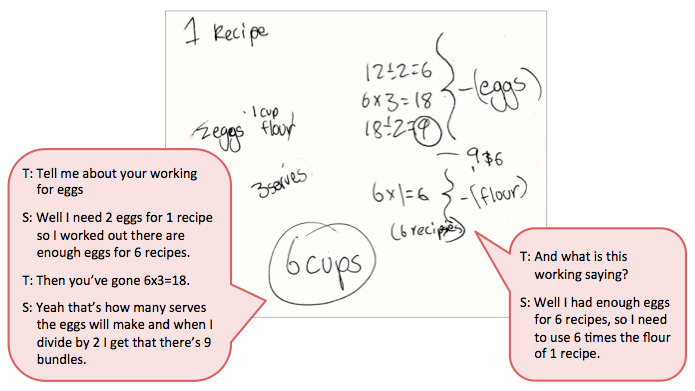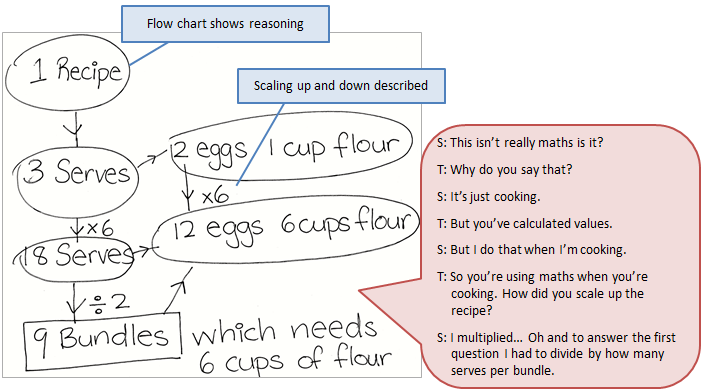The purpose of this activity is to engage students in using volume/capacity calculations to solve a problem.
This activity assumes the students have experience in the following areas:
- Representing part-whole proportions as fractions.
- Finding proportions in part-whole situations.
- Solving word problems with proportions.
The problem is sufficiently open ended to allow the students freedom of choice in their approach. It may be scaffolded with guidance that leads to a solution, and/or the students might be given the opportunity to solve the problem independently.
The example responses at the end of the resource give an indication of the kind of response to expect from students who approach the problem in particular ways.
 Frieda wants to make 2-serving sized bundles of pasta to store in the freezer.
Frieda wants to make 2-serving sized bundles of pasta to store in the freezer.
Her pasta recipe requires 2 eggs and 1 cup of flour for three servings.
She has one dozen eggs to use. How many bundles can she make?
How much flour will she need?
The following prompts illustrate how this activity can be structured around the phases of the Mathematics Investigation Cycle.
Make sense
Introduce the problem. Allow students time to read it and discuss in pairs or small groups.
- Do I understand the situation? (Students might draw on their experiences with cooking.)
- Does this look/sound like a problem I have worked on before?
- What kind of problem is this? (This is a ratio (or rate) problem.)
- What will my solution look like? (The solution will be the number of bundles that can be made, and the amount of flour needed.)
Plan approach
Discuss ideas about how to solve the problem. Emphasise that, in the planning phase, you want students to say how they would solve the problem, not to actually solve it.
- What ways to organise the information might be helpful? (Ratio tables are very useful for solving problems of this type as they help students keep track of various amounts.)
- What are the maths skills I need to work this out? (Students will need to apply multiplication and division to the amounts in the ratios.)
- Do I expect there to be patterns? What kinds of patterns do I expect?
- Do I have a sense of what might be a reasonable answer?
- What tools (digital or physical) could help my investigation?
Take action
Allow students time to work through their strategy and find a solution to the problem.
- Have I recorded my ideas in a way that helps me to see patterns and keep track of the amounts?
- Are there any patterns?
- How might I describe the patterns?
- Does the pattern help me to answer the question?
- Is my strategy working or do I need to change?
- Is there another possible answer or way to solve it?
- Does my solution make sense? Does it match my estimation?
- Does my solution answer the question?
Convince yourself and others
Allow students time to check their answers and then either have them pair share with other groups or ask for volunteers to share their solution with the class.
- What is the solution?
- Is my working clear enough for someone else to follow?
- Am I sure there are no errors? How?
- How would I convince someone else I am correct?
- Could I have solved the problem in a more efficient way?
- Were the strategies I chose effective?
- Is there maths I need to learn after solving this problem?
Examples of work
Work sample 1
The student systematically follows a series of calculation steps to find the solution to a proportional reasoning problem.
Click on the image to enlarge it. Click again to close. 
Work sample 2
The student uses calculations to scale the ingredients in the recipe for pasta up and down and finds a correct answer independently.
Click on the image to enlarge it. Click again to close. 
Work sample 3
The student creates the equivalent of a ratio table to organise the scaling of ingredients in the recipe. They find a correct answer independently.
